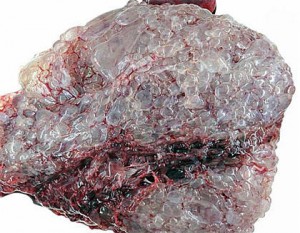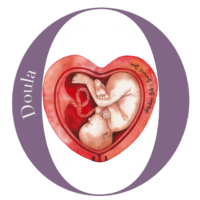There are two types of molar pregnancy:
Complete molar pregnancy. An egg with no genetic information is fertilized by a sperm. The sperm grows on its own, but it can only become a growth of placental tissue (hence a positive pregnancy test) and cannot become a fetus. In a complete mole, all of the fertilized egg’s chromosomes (tiny thread-like structures in cells that carry genes) come from the father. Normally, half come from the father and half from the mother. In a complete mole, shortly after fertilization, the chromosomes from the mother’s egg are lost or inactivated, and those from the father are duplicated. As this tissue grows, it looks a bit like a cluster of grapes. This cluster of tissue can very rapidly fill the uterus.
Partial molar pregnancy. An egg is fertilized by two sperm. If an abnormal embryo does begin to develop, it will quickly die because of the rapidly growing mass of abnormal tissue filling your uterus. In most cases of partial mole, the mother’s 23 chromosomes remain, but there are two sets of chromosomes from the father (so the embryo has 69 chromosomes instead of the normal 46). This can happen when the chromosomes from the father are duplicated or if two sperm fertilize an egg.
Molar pregnancy poses a threat to the pregnant woman because it can occasionally result in a rare pregnancy-related form of cancer called choriocarcinoma (see end of document).
Molar pregnancy is assessed with a pelvic exam and ultrasound. The abnormal placenta mass will have a clustered, grape like appearance.
For these and other serious medical risks, the molar pregnancy is immediately ended with medical support. This is generally done with a D&C. Afterward, you will have regular blood tests to look for signs of trophoblastic disease. These blood tests will be done over the next 6 to 12 months. Your doctor will caution you that you will need to use birth control for the next 6 to 12 months so that you don’t get pregnant. It is very important to see your doctor for all follow-up visits.
While a positive pregnancy test detects the placenta hormones (not an actual baby), finding out that you are pregnant can be the beginning of a hopes, aspirations and joy.
“The fact that a (complete) molar pregnancy does not result in a baby (or, twins) can be equally–if not more–devastating than any other kind of miscarriage.
Please be gentle on yourself and know that your loss is worthy to grieve.”
– stillbirthday mother
Finding out what to expect from a D&C, and allowing yourself to experience healthy grief with a farewell celebration can be very useful and positive for you.
Please also utilize long term support services and emotional/spiritual health support services listed here in this website.
One stillbirthday mother suggests asking your trusted healthcare provider about drinking Chaga tea during your postpartum healing.
It is also very important to reach out, and tell others about your story. Please consider sharing your experience with us here, and reading the stories shared here by other mothers who’ve experienced molar pregnancy.
We’d be so honored to learn from you and to cry with you.
~~~~~~~~~~
If you are interested in seeing what a molar pregnancy may look like,
below is a very graphic image:
~~~~~~~~~~
About Gestational Trophoblastic Disease – from cancer.org:
What is gestational trophoblastic disease?
Gestational trophoblastic disease (GTD) is a group of rare tumors that involve abnormal growth of cells inside a woman’s uterus. GTD does not develop from cells of the uterus like cervical cancer or endometrial (uterine lining) cancer do. Instead, these tumors start in the cells that would normally develop into the placenta during pregnancy. (The term gestationalrefers to pregnancy.)
GTD begins in the layer of cells called the trophoblast that normally surrounds an embryo. (Tropho- means nutrition, and -blast means bud or early developmental cell.) Early in normal development, the cells of the trophoblast form tiny, finger-like projections known as villi. The villi grow into the lining of the uterus. In time, the trophoblast layer develops into the placenta, the organ that protects and nourishes the growing fetus.
Most GTDs are benign (not cancer) and they don’t invade deeply into body tissues or spread to other parts of the body. But some are malignant (cancerous). Because not all of these tumors are cancerous, this group of tumors may be referred to as gestational trophoblastic disease, gestational trophoblastic tumors, or gestational trophoblastic neoplasia. (The word neoplasia simply means new growth.)
All forms of GTD can be treated. And in most cases the treatment produces a complete cure.
Types of gestational trophoblastic disease
The main types of gestational trophoblastic diseases are:
- Hydatidiform mole (complete or partial)
- Invasive mole
- Choriocarcinoma
- Placental-site trophoblastic tumor
- Epithelioid trophoblastic tumor
Hydatidiform mole
The most common form of GTD is called a hydatidiform mole, also known as a molar pregnancy. It is made up of villi that have become swollen with fluid. The swollen villi grow in clusters that look like bunches of grapes. This is called a molar pregnancy, but it is not possible for a normal baby to form. Hydatidiform moles are not cancerous, but they can develop into cancerous GTDs.
There are 2 types of hydatidiform moles: complete and partial.
A complete hydatidiform mole most often develops when either 1 or 2 sperm cells fertilize an egg cell that contains no nucleus or DNA (an “empty” egg cell). All the genetic material comes from the father’s sperm cell. Therefore, there is no fetal tissue.
Surgery can totally remove most complete moles, but as many as 1 in 5 women will have some persistent molar tissue (see below). Most often this is an invasive mole, but rarely it is a choriocarcinoma, a malignant (cancerous) form of GTD. In either case it will require further treatment.
A partial hydatidiform mole develops when 2 sperm fertilize a normal egg. These tumors contain some fetal tissue, but this is often mixed in with the trophoblastic tissue. It is important to know that a viable (able to live) fetus is not being formed.
Partial moles are usually completely removed by surgery. Only a small number of women with partial moles need further treatment after initial surgery. Partial moles rarely develop into malignant GTD.
Persistent gestational trophoblastic disease is GTD that is not cured by initial surgery. Persistent GTD occurs when the hydatidiform mole has grown from the surface layer of the uterus into the muscle layer below (called the myometrium). The surgery used to treat a hydatidiform mole (called suction dilation and curettage, or D&C) scrapes the inside of the uterus. This removes only the inner layer of the uterus (the endometrium) and cannot remove tumor that has grown into the muscular layer.


Most cases of persistent GTD are invasive moles, but in rare cases they are choriocarcinomas or placental site trophoblastic tumors (see below).
Invasive mole
An invasive mole (formerly known as chorioadenoma destruens) is a hydatidiform mole that has grown into the muscle layer of the uterus. Invasive moles can develop from either complete or partial moles, but complete moles become invasive much more often than do partial moles. Invasive moles develop in a little less than 1 out of 5 women who have had a complete mole removed. The risk of developing an invasive mole in these women increases if:
- There is a long time (more than 4 months) between the last menstrual period and treatment.
- The uterus has become very large.
- The woman is older than 40 years.
- The woman has had GTD in the past.
Because these moles have grown into the uterine muscle layer, they aren’t completely removed during a D&C. Invasive moles can sometimes go away on their own, but most often more treatment is needed.
A tumor or mole that grows completely through the wall of the uterus may result in bleeding into the abdominal or pelvic cavity. This bleeding can be life threatening.
Sometimes after removing a complete hydatidiform mole, the tumor spreads (metastasizes) to other parts of the body, most often the lungs. This occurs about 4% of the time (or 1 in 25 cases).
Choriocarcinoma
Choriocarcinoma is a malignant form of GTD. It is much more likely than other types of GTD to grow quickly and spread to organs away from the uterus.
Choriocarcinoma most often develops from a complete hydatidiform mole, but it can also occur after a partial mole, a normal pregnancy, or a pregnancy that ends early (such as a miscarriage or an elective abortion).
Rarely, choriocarcinomas that are not related to pregnancy can develop. These can be found in areas other than the uterus, and can occur in both men and women. They may develop in the ovaries, testicles, chest, or abdomen. In these cases, choriocarcinoma is usually mixed with other types of cancer, forming a type of cancer called a mixed germ cell tumor.
These tumors are not considered to be gestational (related to pregnancy) and are not discussed in this document. Non-gestational choriocarcinoma can be less responsive to chemotherapy and may have a less favorable prognosis (outlook) than gestational choriocarcinoma. For more information about these tumors, see our documents, Ovarian Cancer and Testicular Cancer.
Placental-site trophoblastic tumor
Placental-site trophoblastic tumor (PSTT) is a very rare form of GTD that develops where the placenta attaches to the lining of the uterus. This tumor most often develops after a normal pregnancy or abortion, but it may also develop after a complete or partial mole is removed.
Most PSTTs do not spread to other sites in the body. But these tumors have a tendency to grow into (invade) the muscle layer of the uterus.
Most forms of GTD are very sensitive to chemotherapy drugs, but PSTTs are not. Instead, they are treated with surgery, aimed at completely removing disease.
Epithelioid trophoblastic tumor
Epithelioid trophoblastic tumor (ETT) is an extremely rare type of GTD that can be hard to diagnose. ETT used to be called atypical choriocarcinoma because the cells look like choriocarcinoma cells under the microscope, but it is now thought to be a separate disease. Because it can be found growing in the cervix, it can also sometimes be confused with cervical cancer. Like PSTT, ETT most often occurs after a full-term pregnancy, but it can take several years after the pregnancy for the ETT to occur. Also, like PSTT, ETT does not respond very well to chemotherapy drugs, so the main treatment is surgery. It might have already metastasized when it is diagnosed which carries a poorer prognosis (outlook).
You have permission to use this photo for social media awareness. Just visit stillbirthday on Facebook to grab and share the photo.














